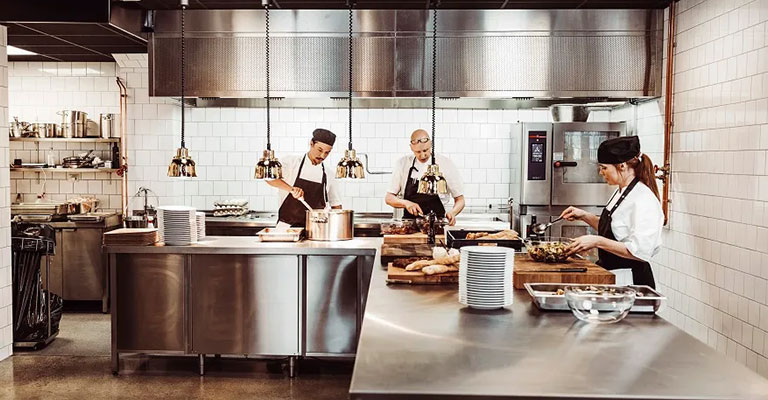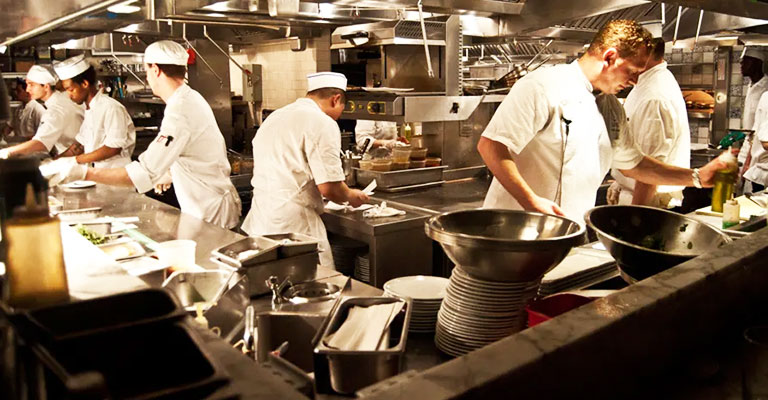What Is A Central Kitchen?-An All-Encompassing Guide
A central kitchen is the linchpin of large-scale food production, revolutionizing how the culinary industry meets high-demand scenarios. It’s a specialized facility meticulously designed for streamlined, high-efficiency operations.
Within its walls, raw ingredients are transformed into culinary creations, thanks to specialized equipment and standardized processes.
This centralized approach enables businesses to achieve cost savings, maintain consistent quality, and adapt swiftly to evolving consumer preferences. From restaurant chains to meal kit services, central kitchens serve as the heartbeat of diverse food enterprises.
With modern technology integration and unwavering commitment to food safety, these kitchens epitomize the future of efficient, high-quality food preparation.

What Is A Central Kitchen?
A central kitchen, also known as a commissary kitchen or a production kitchen, is a facility designed for the large-scale preparation, cooking, and assembly of food.
It serves as a centralized hub where food is produced in bulk and then distributed to various locations, such as restaurants, catering businesses, food delivery services, and other food-related businesses.
Here are some key aspects of a central kitchen:
Large-Scale Production
Central kitchens often boast specialized equipment like industrial ovens, commercial mixers, and high-capacity refrigeration units. This allows them to process large quantities of raw ingredients efficiently.
The layout of a central kitchen is meticulously designed to facilitate a smooth flow of ingredients from preparation stations to cooking areas, and finally to packaging and storage.
Efficiency and Standardization
To maintain consistency, central kitchens strictly follow standardized recipes and cooking techniques. This ensures that each item produced adheres to the established quality standards, regardless of who is preparing it.
Quality control measures are implemented throughout the production process, often involving trained staff who monitor taste, texture, and appearance.
Cost Efficiency
By centralizing operations, businesses can take advantage of bulk purchasing, potentially securing better prices for ingredients. This can lead to significant cost savings compared to individual kitchens.
Additionally, labor costs can be optimized as tasks are often specialized, allowing employees to focus on specific aspects of food production.
Streamlined Operations
Central kitchens often employ techniques like “just-in-time” inventory management to reduce waste and keep food as fresh as possible. This helps minimize excess inventory that might otherwise go to waste.
Efficient scheduling and production planning are key components of a central kitchen’s operations, ensuring that resources are utilized optimally.
Distribution Hub
Central kitchens have a well-coordinated logistics system in place. This includes specialized packaging and delivery processes to ensure that food reaches its destination in a timely and safe manner.
Temperature-controlled vehicles and storage facilities are often utilized to maintain the quality and safety of the food during transit.
Regulatory Compliance
Meeting health and safety standards is of paramount importance in a central kitchen. They must adhere to strict regulations regarding food handling, storage, and sanitation practices.
Regular inspections by health authorities help to ensure ongoing compliance and central kitchens often have staff dedicated to maintaining these high standards.
Menu Flexibility
Central kitchens have the capability to produce a diverse array of food items. This adaptability allows them to cater to the specific needs and preferences of their clients.
Some central kitchens may also have the capacity for rapid menu changes, enabling businesses to respond quickly to shifts in consumer demand.
Adaptability to Different Cuisines
Central kitchens can be customized to accommodate a wide range of culinary styles.
This might involve specialized equipment for specific cooking techniques or the incorporation of unique ingredients.
Reduced Footprint for Individual Outlets
For restaurants and food businesses with multiple outlets, centralizing production can lead to significant space savings at each location. This can result in more efficient use of valuable real estate.
Supports Food Delivery and Catering Services
With the surge in food delivery services and catering demands, central kitchens have become indispensable.
They provide a reliable source of consistently prepared food, which is crucial for businesses in these sectors to maintain high customer satisfaction levels.
Technology Integration
Many modern central kitchens leverage technology for tasks like automated inventory tracking, order processing, and quality control.
This integration of technology streamlines operations reduces human error and enhances overall efficiency.
Industries That Utilize Central Kitchens

Central kitchens are widely utilized by various industries in the food and beverage sector. These facilities offer significant advantages in terms of efficiency, consistency, and cost savings.
Here are some of the key industries that make use of central kitchens:
Restaurant Chains
Restaurant chains with multiple locations often rely on central kitchens to ensure that their menu items are consistent in taste and quality across all outlets.
This centralization allows for standardized preparation methods and ingredient sourcing.
Fast Food Chains
Fast food chains, known for their high-speed service and consistent menu offerings, frequently use central kitchens.
These facilities handle the production of key menu items, ensuring uniformity in taste and presentation.
Catering Services
Catering companies that serve events, ranging from weddings to corporate functions, often operate central kitchens.
These facilities are equipped to handle large-scale food preparation to meet the demands of sizable gatherings.
Food Delivery Services
In the rapidly growing sector of food delivery, central kitchens play a crucial role.
Companies like cloud kitchens and third-party delivery services rely on these facilities to efficiently produce and dispatch orders for home delivery.
Grocery Stores
Some grocery stores have their own central kitchens. These kitchens produce a range of items, from deli sandwiches to pre-packaged meals, offering customers convenient options for ready-to-eat or easy-to-prepare foods.
Meal Kit Services
Meal kit companies provide customers with pre-portioned ingredients and recipes for cooking at home. Central kitchens are integral to the assembly and packaging process, ensuring that customers receive high-quality ingredients.
Schools and Institutions
Educational institutions, healthcare facilities, and corporate cafeterias often rely on central kitchens.
These kitchens produce meals in large quantities to serve students, patients, or employees while adhering to dietary and nutritional requirements.
Airline Catering
Central kitchens are crucial to the airline industry for the preparation of in-flight meals.
These kitchens operate under strict guidelines to ensure that meals are safe, delicious and served efficiently to passengers.
Hotel Chains
Large hotel chains often maintain central kitchens to supply food to their in-house restaurants, room service, banquets, and catering services. This centralized approach allows for efficient management of food production.
Food Manufacturing
Food manufacturing companies often have central kitchens for producing ingredients or components used in various food products.
For instance, a company producing sauces may have a central kitchen for preparing and packaging them for distribution.
Food Startups and Ghost Kitchens
New food businesses, including ghost kitchens and delivery-only brands, often start with a central kitchen setup.
This allows them to efficiently fulfill customer orders without the overhead costs associated with a traditional restaurant.
Commissaries for Food Trucks
Food trucks often rely on commissaries or central kitchens where they prepare ingredients or entire menu items. These items are then transported to their mobile kitchens for final preparation and service.
Components of a Central Kitchen

A central kitchen is a complex facility designed for large-scale food production. It comprises various essential components that work together to ensure efficiency, consistency, and quality in food preparation.
Here are the key components of a central kitchen:
Food Preparation Area
The food preparation area is where raw ingredients are received and processed. This includes tasks such as washing, cutting, marinating, and portioning.
Workstations are equipped with the necessary tools and equipment to handle different types of ingredients.
Cooking Stations
This section houses the cooking equipment required for preparing various dishes. It includes ovens, stovetops, grills, fryers, and other specialized appliances. Each station is designed to handle specific cooking methods and techniques.
Assembly Area
In the assembly area, cooked elements are combined to create final dishes. This involves tasks like plating, arranging ingredients, and ensuring that each dish meets the required presentation standards.
Packaging and Labeling Zone
After food is prepared, it needs to be properly packaged and labeled for distribution.
This area is equipped with packaging materials, sealing machines, and labeling equipment to ensure that products are properly identified.
Cold Storage
Walk-in refrigerators and freezers are essential for storing perishable ingredients, prepared foods, and finished products at the appropriate temperatures. Proper organization and shelving allow for easy access to items.
Dry Storage
This area is dedicated to storing non-perishable items like canned goods, grains, and dry ingredients. It requires proper shelving and organization to facilitate easy access and efficient inventory management.
Warehousing and Distribution Area
This space is used for storing packaged goods before they are distributed to various outlets. It may include loading docks for efficient loading and unloading of products.
Waste Management and Recycling Zone
Proper disposal of food waste and recyclables is crucial for maintaining cleanliness and sustainability.
This area is equipped with waste bins, recycling stations, and possibly composting facilities.
Cleaning and Sanitizing Stations
To ensure a high level of hygiene, central kitchens have designated areas for cleaning and sanitizing kitchen equipment, utensils, and workspaces. This includes sinks, dishwashers, and stations for thorough cleaning.
Staff Facilities
This area includes facilities such as restrooms, break rooms, and changing areas for employees.
It provides a comfortable and functional space for staff members to take breaks, eat meals, and attend to personal needs.
Administrative and Office Space
This area is designated for managerial tasks, including scheduling, planning, inventory management, and administrative work associated with the central kitchen’s operations. It provides a space for staff to handle paperwork and conduct meetings.
Quality Control and Inspection Stations
Here, food items are inspected for quality, taste, and adherence to standardized recipes.
Quality control personnel play a critical role in ensuring consistency and excellence in the final products.
Safety and First Aid Stations
Equipped with first aid kits, fire extinguishers, and safety equipment, this area is dedicated to ensuring the well-being of employees. It provides resources to address any emergencies that may arise during operations.
Technology and Automation Systems
Modern central kitchens often incorporate technology for tasks like inventory management, order processing, and quality control. This integration streamlines operations and enhances overall efficiency.
Security Measures
Security features such as surveillance cameras, access controls, and alarms are implemented to safeguard the premises and its assets, ensuring a secure working environment for staff members.
Benefits of Implementing a Central Kitchen

Implementing a central kitchen offers several benefits to businesses in the food and beverage industry. These advantages can have a significant impact on operational efficiency, cost savings, and the overall quality of products and services.
Here are some key benefits of using a central kitchen:
Consistency in Quality
Central kitchens follow standardized recipes and cooking methods, ensuring that every item produced meets specific quality standards. This consistency is crucial for maintaining the reputation of a brand or restaurant chain.
Efficiency in Production
Large-scale production in a central kitchen allows for the efficient processing of food in high volumes. This efficiency leads to reduced production time and labor costs.
Cost Savings
Central kitchens can take advantage of economies of scale, resulting in cost savings.
Bulk purchasing of ingredients, reduced labor requirements, and streamlined operations contribute to lower production costs.
Reduced Food Waste
Centralized production often leads to better inventory management. This can minimize food waste as ingredients are ordered and used more efficiently, and excess inventory is reduced.
Menu Diversification
Central kitchens offer the flexibility to produce a wide range of menu items, allowing businesses to expand their offerings and cater to various culinary preferences without the need for extensive on-site kitchen space.
Streamlined Operations
Central kitchens are designed with optimal workflow in mind. The layout and organization of the kitchen minimize wasted time and resources, resulting in a more efficient operation.
Support for Multiple Outlets
Central kitchens can supply food to numerous outlets, reducing the need for extensive kitchen facilities at each location. This leads to space savings and more efficient use of real estate.
Adherence to Health and Safety Standards
Central kitchens must comply with strict health and safety regulations. This ensures that food handling, sanitation, and storage practices are in line with industry standards.
Enhanced Food Delivery Services
The rise of food delivery platforms benefits from central kitchens, which produce a steady supply of prepared food for quick delivery to customers’ homes, improving delivery speed and consistency.
Quality Control
Central kitchens often have dedicated quality control personnel who monitor taste, texture, and appearance, ensuring that every dish meets the desired standards of excellence.
Technology Integration
Many modern central kitchens incorporate technology for inventory management, order processing, and quality control. This technological integration improves overall efficiency and reduces the margin for error.
Improved Resource Management
Central kitchens allow for better allocation of resources. Staff members can specialize in specific tasks, which enhances productivity and reduces labor costs.
Scalability
Central kitchens are designed to accommodate growth. As a business expands, it can easily scale up production in a central kitchen without the need for significant additional infrastructure.
Reduced Kitchen Footprint for Outlets
Restaurants and food businesses can have smaller on-site kitchens when they rely on a central kitchen. This reduces the space and equipment requirements at individual locations.
Sustainability
Central kitchens can implement sustainable practices like food waste reduction, energy-efficient equipment, and eco-friendly packaging, contributing to a more environmentally responsible operation.
Examples of Well-Known Central Kitchens
Several well-known central kitchens have gained recognition for their role in the food industry. These central kitchens serve as hubs for large-scale food production and distribution, supplying various food businesses and outlets.
Here are some examples of prominent central kitchens:
McDonald’s Central Kitchen
McDonald’s, one of the world’s largest fast-food chains, operates central kitchens to produce key menu items, such as burger patties and chicken nuggets.
These central kitchens are crucial for ensuring consistency and quality across their numerous global locations.
Starbucks Reserve Roastery and Tasting Room
Starbucks has a central kitchen in Seattle dedicated to the production of its Reserve coffee beans.
These beans are then supplied to Starbucks Reserve Roastery locations, offering a premium coffee experience to customers.
Marley Spoon
Marley Spoon is a meal kit delivery service with a central kitchen.
The central kitchen assembles pre-portioned ingredients for its meal kits, which are delivered to customers for convenient cooking at home.
Kitchen United
Kitchen United is a network of central kitchens and ghost kitchens that partners with various restaurant brands. These shared kitchen spaces are designed to help businesses fulfill delivery and takeout orders efficiently.
Catering by Michael’s
Catering by Michaels is a well-known catering company that operates a central kitchen for the preparation of food for various events, including weddings, corporate functions, and social gatherings.
EAT Club
EAT Club is a corporate catering service that relies on a central kitchen to prepare and deliver customized meals to businesses for employee lunches and events.
Blue Apron
Blue Apron, a popular meal kit delivery service, operates central kitchens where they assemble and package meal kits.
These kits are then shipped to customers, allowing them to prepare restaurant-quality meals at home.
Sprig
Sprig was an on-demand meal delivery service that operated central kitchens in select cities. They prepared fresh, healthy meals for quick delivery to customers’ homes.
Otarian
Otarian was a sustainable fast-food restaurant chain that used central kitchens to prepare its eco-friendly menu items, including vegetarian and vegan options.
CloudKitchens
CloudKitchens is a company that provides shared kitchen space to various restaurant brands. They operate multiple central kitchens and ghost kitchens to support food delivery and takeout orders.
Sweetgreen
Sweetgreen, a popular salad and grain bowl chain, operates a central kitchen in
California where they prepare various ingredients and dressings for their salads. These items are then distributed to their numerous locations.
FAQs
What is a Central Kitchen?
A central kitchen is a specialized facility designed for large-scale food production.
Can a Central Kitchen Cater to Different Types of Cuisines?
Yes, central kitchens are versatile and can be tailored to produce various types of cuisine.
What Are the Key Components of a Central Kitchen?
The key components of a central kitchen include food preparation areas, cooking stations, assembly areas, packaging and labeling zones, cold and dry storage, warehousing and distribution areas, waste management zones, cleaning stations, and more.
Is Quality Control a Priority in a Central Kitchen?
Yes, quality control is paramount in a central kitchen. It involves monitoring taste, texture, and appearance of standardized recipes to ensure that every item produced meets specific quality standards.
Can a Central Kitchen Help Reduce Costs for Businesses?
Yes, central kitchens often lead to cost savings for businesses.
To Recap
A central kitchen stands as a cornerstone of large-scale food production and distribution.
This specialized facility streamlines operations, ensuring efficiency, consistency, and cost-effectiveness. By centralizing tasks like preparation, cooking, and assembly, businesses can achieve economies of scale and maintain high-quality standards.
This model caters to a wide range of industries, from restaurants and catering services to food delivery platforms. Embracing technology and adhering to strict health and safety regulations, central kitchens exemplify the epitome of modern food production.
With their ability to meet diverse culinary demands, central kitchens play a vital role in satisfying the appetites of today’s dynamic and discerning consumer base.




